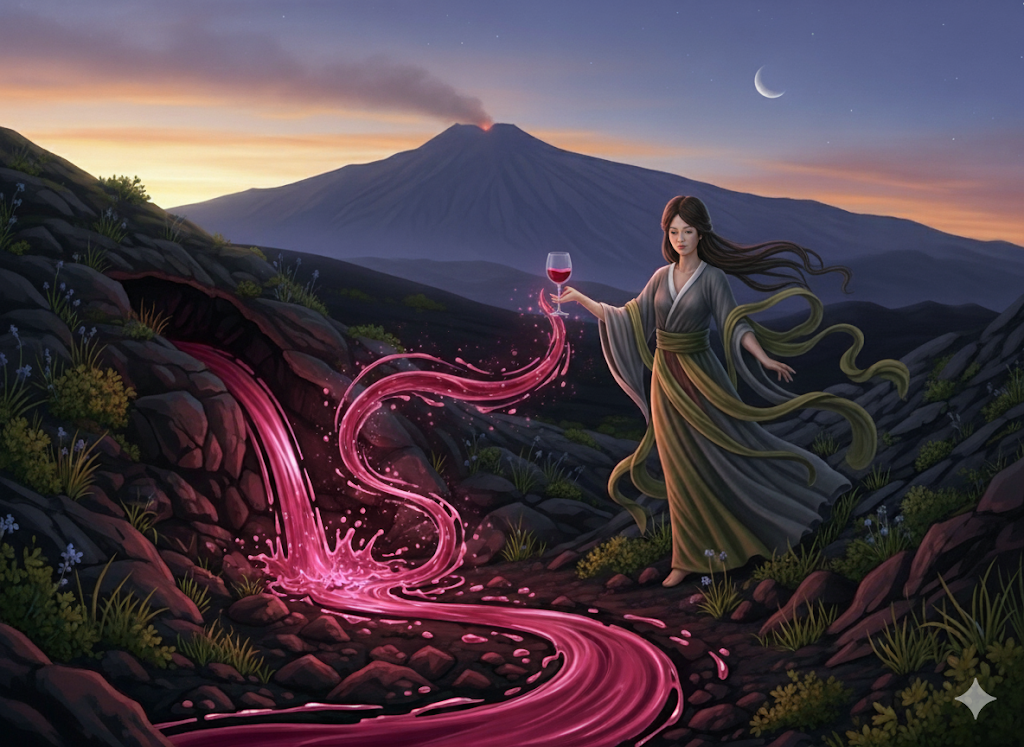Etna: Where Ash Remembers the Vine
Explore Etna’s wines where vineyards cling to cooling lava. From Nerello Mascalese’s smoky grace to Carricante’s saline lift, this deep‑dive reveals geology, history, producers, and the philosophy of collecting bottles born from the mountain’s perpetual rebirth.

Some landscapes are born each morning, but Mount Etna is reborn every time she exhales. The Sicilians call her Mungibeddu—the mountain that belches. I first saw her at dawn, her summit veiled in rose‑grey plume, her skirts stitched with terraces of gnarled vines. In that hushed half‑light, the air tasted faintly of cold iron and burnt sage, as though memory itself had been reduced to smoke and scattered over the Ionian Sea.
The Mountain Stirs
Etna is not merely Europe’s tallest active volcano; she is a chronometer of creation. Basaltic rivers hardened into terraces; obsidian slabs fracture under vine roots; pumice stones still hiss with the ghost of ancient steam. Each eruption layers new chapters over the older soils, an endless palimpsest of lava—historic flows from 122 BCE mingle with the silvery ash of 1928, and both cradle this year’s Nerello buds. Elevation ranges from 450 to over 1 000 meters, climbing in concentric rings like a great black amphitheater facing the sea. And within that altitude sweep lies a climate swing a continent wide: citrus‑soft breezes brush the lower contrade while, higher up, vines shiver under snow until April. Here, ripening is slower, acidity keener, and the grapes speak with an accent etched by cold nights and mineral hunger.
But Etna’s geology is not a static set piece. When the mountain groans—last in May 2024—lava tongues rewrote the vine rows of Linguaglossa overnight. Farmers watched century‑old carricante trunks smolder, then pierced the cooling crust with new cuttings a month later. Rebirth through fire is no motto here; it is the business plan.
Ash and Altitude
Step off the coast road and climb: at 500 meters, sandy black soils feel almost weightless, as though your boots might float. Nerello Mascalese grown here often glimmers ruby‑pale, its tannins lacy, its red‑currant flavors edged with blood orange. Ascend another 200 meters and the lava turns gravelly, chunked with pyroxene and olivine. Rain drains quickly, stressing vines into sparse yields; Mascalese tightens, grows angular, whispers of rose stem and iron filings.
Above 800 meters, old flows from the 17th‑century flank eruption dominate—porous, chalk‑flecked, bleached like antique parchment. Carricante thrives in these altitudes where fog rolls up from the Alcantara Valley. The wines taste of lemon pith, salt, and mountain fennel—sunlight filtered through stone dust.
Yet terroir here is spelled in contrade, micro‑parcels carved by lava tongues. Passopisciaro’s Contrada Guardiola (820 m) commands views of smoking craters; its wines hum with electric tension. Meanwhile, Calderara Sottana, studded with pumice as light as meringue, yields reds that feel paradoxically weighty—smoke shimmering around black‑cherry fruit.
Orientation matters too. North‑facing slopes drink in long, languid daylight; the west basks in molten sunsets that thicken skins and thoughts alike. Etna’s terroir is a sundial whose gnomon is fire.
Grapes That Speak in Smoke
Nerello Mascalese is Etna’s storyteller—lean, salt‑rimmed, yet capable of sudden lyricism. Tasted young, it can seem aloof, a sketch in charcoal. Give it time and oxygen, and violets bloom over embers, memories of strawberries roasted under summer roofs. Its tannins are not walls but gauze curtains, filtering light rather than blocking it.
Nerello Cappuccio is Mascalese’s shadow‑twin, deeper hued, softer spoken. It lends a dusk‑purple bass note, a suggestion of plum skin and sweet smoke, the way twilight smells when fig leaves scorch in a hearth.
Carricante is the mountain’s alpine laugh—acid‑bright, saline, lifted. Imagine squeezing a lemon over wet slate, then breathing in the spray. On lees, it gathers texture like snowfall turning to cream atop lava rock. In old age it remembers beeswax, chamomile, and the hush of distant surf.
Rarely discussed but always present is Minnella, the “little nipple,” a pale red grape making whites that taste like pink light on fresh snow. It appears in field blends like a half‑forgotten nursery rhyme—familiar once someone else sings it.
Hands Amid the Cinders
Viticulture here predates Rome. The Greeks planted vines along Etna’s lower skirts, believing Dionysus himself once coaxed shoots out of black stone. Medieval monks terraced the slopes to catch sun and salvation; their dry‑stack walls still stand, patched and leaning like tired psalmists.
In the late 1800s, phylloxera scorched much of Sicily but spared swaths of Etna’s loftiest terraces. Today those ungrafted vines—some over 130 years old—twist like petrified lightning, roots gripping crevices that macro pests cannot navigate.
Modern resurgence began in the 1990s, when brothers Giuseppe and Marco de Grazia saw promise in these abandoned moonscapes. The first bottles of Tenuta delle Terre Nere carried ash‑dust labels that hinted at their origin and their ambition. Soon Benanti, Passopisciaro, and Graci re‑charted the contrade; newer voices—like Eduardo Torres Acosta’s Versante Nord or Valenti’s Quota 1000—now sing the mountain’s evolving chords. Their rivalry is less a contest than a polyphony; each vintage is a stanza in a poem the volcano edits with glowing ink.
Voices of the Crater
Walk with Salvo Foti between his albarello bush vines and he will run calloused fingers over pumice, as though reading braille for an ancient secret. At dawn, winemaker Federica di Carlo ritually sprinkles fresh must onto still‑warm lava stones, returning sugar to what once devoured her grandfather’s vineyard. In Milo, Alberto Graci listens for the sigh of fermentations in concrete vats, refusing pumps so the wines, he says, “never forget gravity.” Such moments reveal a cellar philosophy shaped by humility before a mountain that can reclaim every barrel tomorrow.
Oak usage tends toward restraint: large, neutral botti that breathe rather than imprint; amphorae whose terracotta skins echo Etna’s own porous heart. Macerations are gentle—color is coaxed, not coerced. The resulting wines feel elongated, like silhouettes cast by low winter sun. Ageability is whispered in acids that vibrate years later; a 2008 Nerello Mascalese from Calderara today smells of dried rose and gunflint, its palate still alive, like a melody held on a single cello string.
In the Cellar’s Embered Quiet
Time in bottle works strange alchemy here. Mascalese sheds fruit, gaining the scent of library dust on singed parchment. Cappuccio’s sweetness recedes, revealing cedar and clove. Carricante deepens into salted almond and smoke‑laced marmalade. Collectors note the shift not in months but in moods—the wine moves from sunrise to lunar eclipse.
Pairings? Think swordfish brushed with wild oregano and charred lemon; lamb slow‑roasted over vine cuttings until the meat remembers the bush it came from; caciocavallo swung close to the hearth until blistered, then laid over Carricante like snowfall on basalt.
Table at the Edge of Fire
Etna wines invite contradiction: they are delicate yet volcanic, melancholy yet exuberant. Pour an Etna Rosso alongside braised octopus and potatoes cracked with rosemary, and you taste resilience disguised as comfort food. Pour Etna Bianco with raw langoustine and you glimpse the mountain’s maritime dream—salt against snow, lemon against lava.
These bottles are companions for reflective nights. They do not shout over conversation; they sing beneath it, a basso continuo. On the palate they feel like memories retrieved from smoke: half present, half gone.
On Collecting What Rises
To cellar Etna is to wager on fragility: glass harbors liquid born from disaster, and disaster may strike again. Prices remain accessible—still a fraction of Burgundy’s chalk or Barolo’s marl—but scarcity is the quiet driver. Yields here are slim, sometimes halved by a rogue frost or a curtain of ash. Philosophically, investing becomes an act of faith in impermanence: you buy not security but the story of survival.
Auction houses in London now list Terre Nere’s single‑contrada magnums beside first‑growth Bordeaux. Yet the serious collector understands value here is less about price trajectory than about narrative yield. Each bottle carries provenance written in basalt dust and dated by eruptions. Drinking one is a reminder that beauty can literally erupt from catastrophe—a lesson no stock certificate conveys.
Echoes of Other Volcanoes
Taste Santorini’s Assyrtiko and you’ll find a distant cousin—brinier, wind‑scoured, a shard of sunlight. The Canary Islands’ Listán Negro offers smoked strawberry echoes of Nerello. Even Oregon’s young lava‑bed vineyards borrow Etna’s dialect: acid‑bright, scent of cinder. Yet none share Etna’s constant, visible peril, the living metronome of lava that measures seasons in sighs. Where other volcanoes sleep, Etna mutters in her dreams.
When the Embers Cool
One evening in Milo, the mountain fell silent after a month of sporadic grumbles. Stars emerged, unclouded by ash. I uncorked a Carricante that smelled of crushed chalk and bergamot peel. Sipping, I felt the delicate weight of the wine—like snow settling on warm stone—and sensed both sorrow and thrill. This, I thought, is Etna’s true gift: she teaches us to love what might be lost tomorrow, to taste the present with reverence because the ground beneath us is never still.





